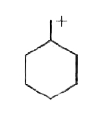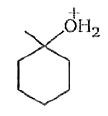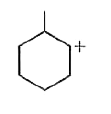Which of the following is expected to be coloured in solutions
Cu+
Cu2+
Ti4+
Sc3+
The correct Answer is:B
To determine which of the given ions is expected to be colored in solution, we need to analyze the electronic configurations of each ion and identify the presence of unpaired electrons. The presence of unpaired electrons in d-block elements typically leads to the formation of colored solutions due to d-d transitions.
1. Analyze Cu⁺ (Copper(I)):
- Electronic Configuration: Copper (Cu) has an atomic number of 29. The electronic configuration of Cu is (Ar) 3d¹⁰ 4s¹.
- For Cu⁺, we remove one electron from the 4s orbital:
- Cu⁺: (Ar) 3d¹⁰.
- Unpaired Electrons: There are 0 unpaired electrons (all d-orbitals are fully filled).
- Color: Since Cu⁺ is diamagnetic (0 unpaired electrons), it does not exhibit color in solution.
2. Analyze Cu²⁺ (Copper(II)):
- Electronic Configuration: For Cu²⁺, we remove two electrons (one from 4s and one from 3d):
- Cu²⁺: (Ar) 3d⁹.
- Unpaired Electrons: There is 1 unpaired electron in the 3d orbital.
- Color: Cu²⁺ is paramagnetic (1 unpaired electron), which means it is expected to be colored in solution.
3. Analyze Ti⁴⁺ (Titanium(IV)):
- Electronic Configuration: Titanium (Ti) has an atomic number of 22. The electronic configuration of Ti is (Ar) 3d² 4s².
- For Ti⁴⁺, we remove four electrons (two from 4s and two from 3d):
- Ti⁴⁺: (Ar).
- Unpaired Electrons: There are 0 unpaired electrons.
- Color: Ti⁴⁺ is diamagnetic (0 unpaired electrons), so it does not exhibit color in solution.
4. Analyze Sc³⁺ (Scandium(III)):
- Electronic Configuration: Scandium (Sc) has an atomic number of 21. The electronic configuration of Sc is (Ar) 3d¹ 4s².
- For Sc³⁺, we remove three electrons (two from 4s and one from 3d):
- Sc³⁺: (Ar).
- Unpaired Electrons: There are 0 unpaired electrons.
- Color: Sc³⁺ is diamagnetic (0 unpaired electrons), so it does not exhibit color in solution.
Conclusion:
Among the given options, only Cu²⁺ is expected to be colored in solution due to the presence of one unpaired electron.
Summary of Results:
- Cu⁺: No color (0 unpaired electrons)
- Cu²⁺: Colored (1 unpaired electron)
- Ti⁴⁺: No color (0 unpaired electrons)
- Sc³⁺: No color (0 unpaired electrons)
Final Answer:
Cu²⁺ is expected to be colored in solutions.
---
- Electronic Configuration: Copper (Cu) has an atomic number of 29. The electronic configuration of Cu is (Ar) 3d¹⁰ 4s¹.
- For Cu⁺, we remove one electron from the 4s orbital:
- Cu⁺: (Ar) 3d¹⁰.
- Unpaired Electrons: There are 0 unpaired electrons (all d-orbitals are fully filled).
- Color: Since Cu⁺ is diamagnetic (0 unpaired electrons), it does not exhibit color in solution.
- Electronic Configuration: For Cu²⁺, we remove two electrons (one from 4s and one from 3d):
- Cu²⁺: (Ar) 3d⁹.
- Unpaired Electrons: There is 1 unpaired electron in the 3d orbital.
- Color: Cu²⁺ is paramagnetic (1 unpaired electron), which means it is expected to be colored in solution.
- Electronic Configuration: Titanium (Ti) has an atomic number of 22. The electronic configuration of Ti is (Ar) 3d² 4s².
- For Ti⁴⁺, we remove four electrons (two from 4s and two from 3d):
- Ti⁴⁺: (Ar).
- Unpaired Electrons: There are 0 unpaired electrons.
- Color: Ti⁴⁺ is diamagnetic (0 unpaired electrons), so it does not exhibit color in solution.
- Electronic Configuration: Scandium (Sc) has an atomic number of 21. The electronic configuration of Sc is (Ar) 3d¹ 4s².
- For Sc³⁺, we remove three electrons (two from 4s and one from 3d):
- Sc³⁺: (Ar).
- Unpaired Electrons: There are 0 unpaired electrons.
- Color: Sc³⁺ is diamagnetic (0 unpaired electrons), so it does not exhibit color in solution.
Among the given options, only Cu²⁺ is expected to be colored in solution due to the presence of one unpaired electron.
- Cu⁺: No color (0 unpaired electrons)
- Cu²⁺: Colored (1 unpaired electron)
- Ti⁴⁺: No color (0 unpaired electrons)
- Sc³⁺: No color (0 unpaired electrons)
Cu²⁺ is expected to be colored in solutions.
Topper's Solved these Questions
- ALCOHOLS, PHENOLS AND ETHERSBook:AAKASH INSTITUTE ENGLISHChapter: ALCOHOLS, PHENOLS AND ETHERSExercise:Try yourself
Explore 5 Videos
- ALCOHOLS, PHENOLS AND ETHERSBook:AAKASH INSTITUTE ENGLISHChapter: ALCOHOLS, PHENOLS AND ETHERSExercise:Exercise
Explore 40 Videos
- ALCOHOLS, PHENOLS AND ETHERS Book:AAKASH INSTITUTE ENGLISHChapter:ALCOHOLS, PHENOLS AND ETHERS Exercise:Try Yourself
Explore 5 Videos
Similar Questions
Knowledge Check
Which of the following is not expected to be intermediate of the following reaction ?
 A
A B
B C
C D
D
Which of the following is coloured ?
View SolutionWhich of the following compounds is expected to be coloured?
View SolutionWhich of the following order is expected to be correct ?
View SolutionWhich of the following pairs is coloured in aqueous solution?
View SolutionWhich of the following pairs does not exhibit colour in solution ?
View SolutionWhich of the following compounds is expected to be the most ionic?
View SolutionWhich of the following is not coloured
View Solution
